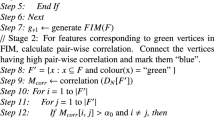Abstract
The exponential growth in the ability to generate, capture, and store high dimensional data has driven sophisticated machine learning applications. However, high dimensionality often poses a challenge for analysts to effectively identify and extract relevant features from datasets. Though many feature selection methods have shown good results in supervised learning, the major challenge lies in the area of unsupervised feature selection. For example, in the domain of data visualization, high-dimensional data is difficult to visualize and interpret due to the limitations of the screen, resulting in visual clutter. Visualizations are more interpretable when visualized in a low dimensional feature space. To mitigate these challenges, we present an approach to perform unsupervised feature clustering and selection using our novel graph clustering algorithm based on Clique-Cover Theory. We implemented our approach in an interactive data exploration tool which facilitates the exploration of relationships between features and generates interpretable visualizations.
Access this chapter
Tax calculation will be finalised at checkout
Purchases are for personal use only
Similar content being viewed by others
Notes
- 1.
Data Repository: https://figshare.com/s/1807247ef2165735465c.
- 2.
Colon Tumor Data: http://csse.szu.edu.cn/staff/zhuzx/Datasets.html.
- 3.
- 4.
References
Aggarwal, C.C., Wolf, J.L., Yu, P.S., Procopiuc, C., Park, J.S.: Fast algorithms for projected clustering. ACM SIGMOD Rec. 28(2), 61–72 (1999)
Agrawal, R., Gehrke, J., Gunopulos, D., Raghavan, P.: Automatic subspace clustering of high dimensional data for data mining applications. In: Proceedings ACM SIGMOD Conference, pp. 94–105 (1998)
Altman, N.S.: An introduction to kernel and nearest-neighbor nonparametric regression. Am. Stat. 46(3), 175–185 (1992)
Augustson, J.G., Minker, J.: An analysis of some graph theoretical cluster techniques. J. ACM (JACM) 17(4), 571–588 (1970)
Bonacich, P.: Some unique properties of eigenvector centrality. Soc. Netw., 555–564 (2007)
Cai, D., Zhang, C., He, X.: Unsupervised feature selection for multi-cluster data. In: Proceedings ACM SIGKDD, pp. 333–342 (2010)
Elgazzar, H., Elmaghraby, A.: Evolutionary centrality and maximal cliques in mobile social networks. Int. J. Comput. Sci. Inf. Tech. 10 (2018)
Erdös, P., Goodman, A.W., Pósa, L.: The representation of a graph by set intersections. Can. J. Math. 18, 106–112 (1966)
Gramm, J., Guo, J., Hüffner, F., Niedermeier, R.: Data reduction and exact algorithms for clique cover. J. Exp. Algorithmics (JEA) 13, 2 (2009)
He, X., Cai, D., Niyogi, P.: Laplacian score for feature selection. In: Advances in Neural Information Processing Systems, pp. 507–514 (2006)
Li, Z., Yang, Y., Liu, J., Zhou, X., Lu, H.: Unsupervised feature selection using nonnegative spectral analysis. In: Proceedings 26th AAAI Conference (2012)
Lu, C., Yu, J.X., Wei, H., Zhang, Y.: Finding the maximum clique in massive graphs. PVLDB 10(11), 1538–1549 (2017)
Mitra, P., Murthy, C., Pal, S.K.: Unsupervised feature selection using feature similarity. IEEE Trans. Pattern Anal. Mach. Intell. 24(3), 301–312 (2002)
Paredes, R., Chávez, E.: Using the k-nearest neighbor graph for proximity searching in metric spaces. In: Consens, M., Navarro, G. (eds.) SPIRE 2005. LNCS, vol. 3772, pp. 127–138. Springer, Heidelberg (2005). https://doi.org/10.1007/11575832_14
Pavan, M., Pelillo, M.: A new graph-theoretic approach to clustering and segmentation. In: Proceedings IEEE Conference Computer Vision & Pattern Recognition (2003)
Robnik-Šikonja, M., Kononenko, I.: Theoretical and empirical analysis of ReliefF and RReliefF. Mach. Learn. 53(1–2), 23–69 (2003)
Rossi, R.A., Gleich, D.F., Gebremedhin, A.H., Patwary, M.M.A.: Fast maximum clique algorithms for large graphs. In: Proceedings WWW, pp. 365–366 (2014)
Solorio-Fernández, S., Carrasco-Ochoa, J.A., Martínez-Trinidad, J.F.: A review of unsupervised feature selection methods. Artif. Intell. Rev. 53(2), 907–948 (2019). https://doi.org/10.1007/s10462-019-09682-y
Speed, T.: A correlation for the 21st century. Science 334(6062), 1502–1503 (2011)
Tarjan, R.E., Trojanowski, A.E.: Finding a maximum independent set. SIAM J. Comput. 6(3), 537–546 (1977)
Wright, M.N., Ziegler, A.: ranger: A fast implementation of random forests for high dimensional data in C++ and R. arXiv preprint arXiv:1508.04409 (2015)
Yang, Y., Shen, H.T., Ma, Z., Huang, Z., Zhou, X.: L2, 1-norm regularized discriminative feature selection for unsupervised. In: Proceedings IJCAI (2011)
Zhao, Z., Liu, H.: Spectral feature selection for supervised and unsupervised learning. In: Proceedings International Conference on Machine Learning, pp. 1151–1157. ACM (2007)
Acknowledgment
This work was funded by the Deutsche Forschungsgemeinschaft (DFG, German Research Foundation) under Germany’s Excellence Strategy – EXC-2023 Internet of Production – 390621612.
Author information
Authors and Affiliations
Corresponding author
Editor information
Editors and Affiliations
Rights and permissions
Copyright information
© 2021 Springer Nature Switzerland AG
About this paper
Cite this paper
Chakrabarti, A., Das, A., Cochez, M., Quix, C. (2021). Unsupervised Feature Selection for Efficient Exploration of High Dimensional Data. In: Bellatreche, L., Dumas, M., Karras, P., Matulevičius, R. (eds) Advances in Databases and Information Systems. ADBIS 2021. Lecture Notes in Computer Science(), vol 12843. Springer, Cham. https://doi.org/10.1007/978-3-030-82472-3_14
Download citation
DOI: https://doi.org/10.1007/978-3-030-82472-3_14
Published:
Publisher Name: Springer, Cham
Print ISBN: 978-3-030-82471-6
Online ISBN: 978-3-030-82472-3
eBook Packages: Computer ScienceComputer Science (R0)




